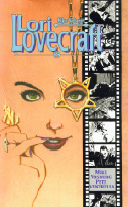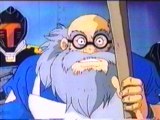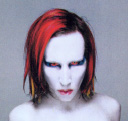Home  Interviews Interviews  Mike Vosburg (conducted by David Thornton in October 2001) Mike Vosburg (conducted by David Thornton in October 2001)
 |
Introduction (from Lori Lovecraft):
Mike grew up with his imagination whetted by the illustrations of N.C. Wyeth, Alfred Hitchcock and Bob Hope movies, and Sax Rohmer's Fu Manchu stories and anything else that would send chills up his spine. And of course he read every comic he could lay his hands on.
No surprise that after stints at schoolteaching, coaching basketball, and working on the assembly line Voz would up as a cartoonist, scribbling away madly at Marvel and DC for a number of years. |
In 1985 Mike and his lovely wife Annie (the model for Lori) moved to LA where he expanded his work into animation and film. Besides illustrating all of the covers for HBO's Tales From the Crypt, Mike also recently won an Emmy for directing on the animated series Spawn.
Voz's current passions are painting scenes from his favorite films and continuing to design new concepts for his web site, VozArt.com.
David Thornton: When were you first introduced to comic books?
Mike Vosburg: I always had comics around when I was a kid...lots of different types- funny animals, westerns, mysteries, and even a few superheroes. As a very young kid the only comics I had no interest in were war comics. It wasn't until I became a fan of Joe Kubert's work that I had any interest in them at all. Reading about a bunch of dirty unshaven guys in dull colors was not my idea of entertainment.
DT: Did you want to be a comic book artist or a writer when you were younger? If so, what were some of your favorite comic book titles and why did they interest you?
MV: I always liked to doodle. I wanted to become a writer, and I'd sketch little illustrations to go with my story from time to time. I discovered doing the pictures appealed to me a lot more than doing the writing. I started producing my own homemade comics when I was about 11 or 12 and I started to look at the medium with a more discerning eye., Kubert was head and shoulders above anything else I saw - he designed his comics using black to create shape, rather than just using lineart and coloring it in. Later, I was drawn to the E.C. stuff I saw - Williamson, Wood, Davis. I always preferred mystery stories. I always hated the kind of stuff Carmine Infantino did and I hated Marvel comics even more. They were always comics dumbed down for the lowest common denominator.
DT: Who were your greatest influences while learning how to draw?
MV: Again, Kubert and Wood, and Jack Kirby's pre-Marvel stuff. I loved N.C. Wyeth, but it never occurred to me I could attempt anything like his paintings. I learned to draw by copying people I liked. It wasn't until I was a working professional that I actually started to "learn" how to draw...I've been trying to catch up ever since.
DT: After visiting some comic book stores, the oldest issue I could find that lists you as a penciler was Graphic Fantasy Annual #1 from Dale Broadhurst Features. Was this your first job in the comic book business? If not, how did you get started?

Cover for Lori Lovecraft
trade paperback
MV: There were lots of amateur things that I did in the mid 60's, but the first "professional" work I did was for underground comics: Bizarre Sex/Kitchen Sink stuff. The first work I actually got paid for were mystery stories for Gold Key about 1973. After I got my toe in I stayed busy working for Marvel and DC and even did a few jobs for Charlton, since they actually let me ink my own work. I also did a few Lori Lovecraft and Peyote St. Jean stories for Star*Reach.

Cover for G.I.Joe #13
DT: Since you penciled a number of G.I.Joe comic books (issues #9 to 19, 22 and 23) that were advertised on TV, did you create the storyboards for the comic book commercials as well?
MV: Strangely enough, G.I.Joe was probably one of my least favorite assignments. I've always been anti-military, but in the economic depression of the Reagan era, it was the only way to pay the bills. Working for the comic and working for the animated series happened at two different times, and were two VERY different experiences. The comics came earlier. Despite my reservations about the material, the animated series was a joy to be connected with. When I approached Marvel Prod. for storyboard work (along with Hanna-Barbera and a couple other places when I moved to LA) they were loathe to give me anything: artists who draw comics don't understand animation. As an artist who was far more influenced by movies than comics, I proved them wrong; if you understand storytelling, you can adapt to any medium. They had planned to have me assist someone for my first storyboard - but everyone was too busy to teach an assistant - so they eventually just handed me a script and had me jump in - they were planning on major fixes afterwards. The day after I turned it in, I got a call offering me a full time job. And the other places that had brushed me off, once word was out that there was a new board artist around, called shortly after. There was a shortage of good people at the time.
The producers, directors and other board artists that I worked with couldn't have been more helpful. They appreciated my professionalism and creative abilities and always made me feel a part of the team. I didn't like working in a studio - I found it confining. They had no problem with me doing most of the work at home, as long as it was turned in on time and I made whatever meetings that were scheduled. I found myself WORKING at home and going into the office when I wanted to socialize or be entertained. My fellow studio-mate Doug Vandegrift was a frustrated stand-up comic. He kept us all laughing so much when he was around I wonder how anything ever got done sometimes. Don Jorgenson, Frank Paur, Wil Mineo, Larry Houston, Warren Greenwood, Adrian Gonzalez, Jesse Santos (that guy could draw!! - and so many others - they were all great guys.)
DT: What was it like working with G.I.Joe comic book writer Larry Hama?
MV: Larry was about as cold as they come. A very talented guy, but I don't think he ever had a word to say to me beyond the job. He was a stickler for authenticity. I always hated the inking on the books I pencilled because the type of line used on the characters was exactly like the line used on the machinery. When I complained, Larry made it clear that the inker was staying because he knew the equipment.
He probably had a point, but despite the success of the book and royalty money, I was happy to leave the project. True to Marvel form, after I left the book I got a call begging me to crank out an issue because my replacement hadn't come through on deadline. Their carrot on the string was that while they couldn't offer me a bonus for helping me out, there was the royalty. So I do the work, get it in on time, and when the issue comes out it's Russ Heath - who did manage to make the deadline. No one bothered to call and tell me - and the royalty promise was just one more Marvel lie.

Bon Appétit "BA" LeCarr
DT: You mentioned to me earlier that the character Bon Appétit (from the episode "Raise the Flagg!") was based upon you. A funny parallel to that story is that the faces of the G.I.Joe figures were sometimes based on Hasbro employees. So now I'm curious: did any other staff members at Sunbow insert themselves in the G.I.Joe series? If so, do you recall any examples?
MV: I don't remember anyone else who was used in the series. Usually, corporate types are VERY sensitive about the possibility of lawsuits.
DT: What was your favorite episode from the G.I.Joe series?
MV: Probably the one with the fashion models. ["Glamour Girls" - dt]
DT: Considering you helped create the G.I.Joe comic book and TV series, did you ever have any story ideas for either medium?
MV: Not my cup of tea.
DT: Was the production pace on the G.I.Joe TV series quite hectic?

Scene dropped from "The Traitor - Part 2"
MV: I came out of comics which was a very demanding medium at the time. Anyone who was working in comics could do the work in animation - but most of the TV animation folks would have had a hard time drawing for comics. I usually found that I never had to work more than 24-30 hours a week to meet the schedule. In the 90's as comics degenerated, the opposite was true - anyone working in animation could do the work in comics, but not vice-versa.
DT: Did you help in other capacity on G.I.Joe beside creating the storyboards during the second season and The Movie?
MV: I've heard some people took a break to help make background sounds in the sound effects department. (I might have did a couple character designs, but the majority of the work was storyboards.)

Another scene cut from "The Traitor - Part 2"
DT: While you were working on G.I.Joe: The Movie, do you know if there were there any designs or thoughts about what would happen during the third season of G.I.Joe?
MV: Our only question was if there WOULD be a third season of Joes. The one thing I learned in animation is that when management comes around telling everyone there's plenty of work for a long time, get your resume ready and look for another job. The other thing I learned in animation, is that the people who actually run the companies are the same people who ran Marvel and DC.
DT: One of the biggest complaints about the TV series is that no one ever died. Was there a high amount of tension between Sunbow's wishes to create a realistic action-adventure series and Hasbro's concerns about their corporate image? And did you ever think that death should be a part of some of the episodes in the G.I.Joe series?
MV: No. I wasn't attached to the characters per se - they were simply something to draw. I might have wished some of the more complicated ones would die.
DT: [Laughter] How often did you redraw a sequence because Hasbro didn't like the amount of violence or the tone?
MV: I can't remember anything specifically. Changes were simply a part of animation (changes in comics were rare, if ever), and why they were being done wasn't usually questioned because there were so many.
DT: Do you have any anecdotes that you would like to share about working on the G.I.Joe series?
MV: Jesse Santos, 5'6" with a quiet voice and a high pitched laugh suddenly breaking into song with the lungs of an opera tenor.
DT: Did you work on any other Sunbow series after G.I.Joe?

Jem
MV: I did a lot of work on Jem and the Holograms. I actually liked that series much better than G.I.Joe.
DT: Did you still have any of the 3.75" G.I.Joe figures that were released during the 1980s?
MV: Hasbro always sent me EVERY new toy when I was doing the comics (I was very popular with my nieces and nephews) - but we never got anything for the television series.
DT: What's the toughest part about creating a storyboard?
MV: Not letting them know you were finished far ahead of deadline.
DT: Because you have worked in the comic and animation industries, what do you believe are some the strengths and weaknesses of each medium?
MV: In comics, what you turn in is what the public sees. (Even tho it is often inked by someone else.) In animation, the best part of the creative effort is done in pre-production and the end result is usually a poor distillation.
DT: Why are the comic book, television and film industries so much fun for you?
MV: They are what I do for a living. The creative part of it is always exciting and a joy to be connected with. They you have your product turned over to suits who repackage it not based on creative decisions, but on what makes a profit. Consequently, you see a lot of crap where there once was beauty.
DT: After working on comic books like Archer & Armstrong, Bloodshot, Cloak & Dagger, Conan, Green Lantern, Iron Man, John Carter: Warlord of Mars, Micronauts, The Punisher, She-Hulk, Sisterhood of Steel, Star Wars and many other titles, which characters were the most enjoyable to draw and are there any comic book characters that you would love to draw one day?
MV: My all time best comic experience was working for Bob Layton at Valiant. In all my years in comics, he was the only guy who told me he wanted me to do it my way. I only wish the Valiant run could have been longer. People ask me what was my favorite Marvel/comic character. I don't have one, because the work usually became compromised as it passed through someone elses hands. The only comics I did that I'm really proud of are Off-Castes and Lori Lovecraft, because I controlled the final product.
 |
 |
| Pages from Lori Lovecraft |
DT: What is the premise of Lori Lovecraft and what makes the characters and story so appealing to you?
It's magic, Hollywood and a beautiful girl - and I get to cast all my favorite stars in my stories. I get to draw the things I like to draw. And Pete Ventrella writes a great story.
DT: Are there any other projects on the horizon for you?

Musician Marilyn Manson
MV: Strangely, enough my work is very varied. I do a lots of "comps" for an ad agency for the video devision of Disney; I do a lot of storyboards for music videos - Eminem's "Stan the Fan," Gloria Stefani and Eve, Marilyn Manson; I've done a could comic book "Classics Illustratated" stories for Boys Life (love these!!) And I'm doing Harry Potter illustrations for Warner Merchandising... and I teach. That's just what I do for other people...my real kick is still creating my own comics and doing my paintings.
DT: Do you have a favorite snack and/or type of music that helps get the creative juices flowing?
MV: I always start the work day listening to a couple of music from the classical period: Mozart, Haydn, Beethoven - it gets me in the alpha state, and I love the music. After I'm moving, I might switch to something a little more contemporary in the afternoon. I only start to eat after I'm finished working.
DT: Do you follow any artists, writers or characters in the comics industry?
MV: Only Mike Mignola and Frank Miller, and haven't seen much of them lately.

Mike Mignola cover for
Ghost/Hellboy #1
DT: Are there any films or books that you highly recommend?
MV: I think John Sayles is the best director working today. I read mostly trashy mystery/detective/crime fiction, but Michael Chabon's Wonder Boys and The Adventures of Kavalier and Clay are stupendous.
DT: Lastly, do you have any words of wisdom?
MV: Find what you like to do and go after it for all your worth. If eventually you don't have people flocking to you for your uniqueness, at least you'll have the satisfaction of doing what you liked.
My heartfelt thanks to Mr. Vosburg for allowing me to interview him. If you would like to order the amazing LORI LOVECRAFT trade paperback, be sure to drop by his web site.
|